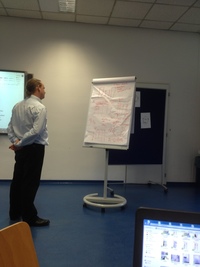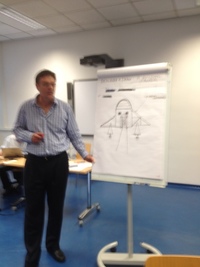austria
Austria - A Jubilee CLIL Teacher Training
Austrian CLIL Teacher Development Course - 10th GroupVienna University of Education Oct 7-9 2015
The tenth group of colleagues came to the most recent CLIL training at the University of Education in Vienna. This training is part of an on-going initiative funded by the Austrian Ministry of Education. It follows on from the Austrian government introducing legislation which demands that specialized High Schools (HTLs) in Austria teach curriculum subjects through the medium of English from the 3rd year of High School education. I am ‘taking stock’ so to speak, as it is 5 years since we started and a round ten groups have been through the course. Also, Putting CLIL into Practice is now published and the acknowledgements in the book pay respect to the work of all of the HTL CLIL teachers who have been on the course and tried out and tested the ideas from ‘3D CLIL’.
![/userfiles/files/G8a.jpg [/userfiles/files/G8a.jpg]](/userfiles/files/G8a.jpg)
The training is a series of four three-day meetings at the University of Education in Vienna. Other training institutions around the country are offering a variety of forms of ongoing professional development for practicing teachers. I’ve been contributing to the training for a number of years now and am responsible along with colleague Simon Hibbert for Modules 1 and 2.
We deal with what I like to call the tools, and the nuts and bolts of CLIL. CLIL is presented and discussed in its 3D form. 3D CLIL refers to three lesson dimensions: concepts, procedures and language. Any or all of these variables may demand an increase or a lowering in support for a group of learners depending on ‘where they are at’ at a given time. Within this framework colleagues are subsequently asked to consider 1) Language Awareness, 2) Guiding Input and 3) Supporting Output.
Language Awareness
This explores with colleagues what layers of language there are in any given CLIL lesson. I talk through and describe three layers of language: subject-specific language; general academic language; peripheral language and give plenty of examples for the teachers to work with to develop their sensitivity and skill at identifying these layers of language in their own subjects. The idea being that armed with this knowledge of the levels of language in their subject areas, colleagues can then go on to raise or lower the amount of ‘language support’ their students need.
Guiding Input
Slideshows, animations, videos, images, objects and talks and many others narrated by the teacher or a ‘voice’ recorded into the medium present ‘input challenge’ to students where they may need some ‘guidance’ to understand their way through the audio-visual content presented. Articles, essays, manuals, written instructions, project descriptions and many other written pieces offer learners further text input challenges and the teacher may need to consider ways and means of guiding learners in order to provide them a pathway through the text input content.
Supporting Output
Students are expected to talk and write in their subject lessons in English. The first thing CLIL teachers need to know is what types of spoken and written ‘texts’ are demanded by their subject. Once this is clear, CLIL teachers need then to be able to visualize the content of these ‘texts’ in diagrams, semi-scripts, frameworks and structures which represent the organization of the ideas and thinking in the ‘texts’ and it is with these structures that learners can be supported to produce their subject standard outputs in spoken or written form.
We start the first module with a needs analysis exercise. Here, the colleagues are given a handout with two fields to fill in for themselves and for their students – what the main problems and challenges are for them to learning in English. This is accompanied by a number of guiding questions, which are not intended to be completely answered, but to offer prompts.
Problems and challenges to teaching in English
Challenge – I teach practicals in design. My students are given projects to do and their work is project-led. It’s difficult for me to do CLIL in this context.
![/userfiles/files/webresearchframe.jpg [/userfiles/files/webresearchframe.jpg]](/userfiles/files/webresearchframe.jpg)
Suggestion – The students have to carry out research using specific websites to read on the background to their projects. Prepare ‘research frames’ to help the students ‘transfer the information’ from the site to their research frames and so ‘read and find key information’.
Challenge – texts are too high level English
Suggestions – texts need to be at the right level
- rewrite them
- shorten them
- summarize them
- simplify them
Understand basic readability (i.e., what makes a text difficult to read)
Challenge – Students see CLIL as an extra ‘burden’
Suggestion – Try to motivate students about why their work in CLIL is useful. One way of doing this is to look to the future and consider work prospects, i.e., many companies want English.
Challenge – It’s a real challenge for me to rethink the way I teach.
Suggestion – You are all experts in your subject area. One thing you will need to do is to look not from the perspective of an expert, but consider the interface between your expert knowledge and your students. How will you get your knowledge across? CLIL is about that interface.
The rest of the first and the second day of the programme is focused on ‘guiding input’ skills. The assignment for the first module is simply for colleagues to take one or two ‘activity types’ from the first module and use them in a lesson from their own subject, record how it goes, get some feedback and upload the whole assignment to the University Moodle for colleagues to read and comment on.
The weakest part, if there is one, is that we don’t involve the English language teachers in the course. It’s been something that was officially decided so as not to create a lack of confidence among the subject teachers. In hindsight, it would have been very useful to have them on board from the word ‘go’.
On the other hand, it’s been a successful model for PD (professional development) for a number of reasons.
1) The teachers are teaching. Not meaning to sound glib, but this means that what the teachers receive in terms of PD, they are able to apply to their teaching immediately.
2) There is time for reflection. Meeting every three or four months for 3 days means that the colleagues get to think about what they are doing and alter things as they see fit based on the course input.
3) 30% of the course input is time to be working on assignments. This is a crucial part of the course, and always comes on the last day. The colleagues have had some input, they’ve been asked to consider a focus for lessons in their subject areas. They sit down and they write lessons. The two course leaders are available to sit and talk with the participants. Usually, we get to talk to everyone in the time we have.
4) The wider picture is one where ‘top-down’ the government has said that it wants CLIL to happen. But, it’s also in a context where schools involved have appointed CLIL coordinators to work with participating teachers and give them support. There is a Google Group ‘HTL CLIL’ with over 200 teachers in it at last count from all over Austria. There is a national network of regional coordinators and a website which publicizes and presents news updates on the project.
5) The teachers are simply very open and receptive to the discussion around the ‘changing of teaching’ that CLIL demands of them. It also can have a positive knock-on effect on their mother-tongue teaching too.
We don’t know how long the course will continue, I suspect as long as teachers are asking for it, the Ministry will fund this professional development opportunity. But, the true evidence of the success of the course will be to see structures and mechanisms in place in schools where departments are coordinating input for their own needs. And this is happening already in some schools!!!


